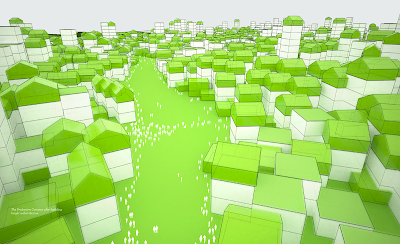Overview
Having identified an emergent organisational structure within our blocks, with clear concentrations of production, we can now begin to prioritise these areas for solar exposure.
The previous algorithms have lacked local rules for regulating building heights, only an overall cap. By introducing a post-processing step at this point we can ensure that the building heights are distributed according to their proximity to productive surfaces. Buildings that are nearer to a productive common will have a lower maximum height. As buildings get further from the common, their maximum height will be higher. Building heights will be highest at the perimeters of the blocks, along the urban circulatory corridors, adding to the different characters of the two spatial zones.
Building Height Rules
The building height redistribution algorithm steps are as follows:
- - First identify the productive commons within each block
- - Set the obstruction angle, according to the local climate and the corresponding sun height
- - For each dwelling, check the proximity to the productive common, and the elevation of the dwelling
- - Check if this data corresponds with the allowable height, dependent on the obstruction angle
- - If the position of the dwelling is too high, look outwards of the productive common to find the first location that matches the criteria. Relocate the dwelling to this new found position
- - Continue the steps for all the dwellings, until all are inside of the obstruction envelope
Parameters
(a) Obstruction Angle
climatic input how steep the Valleys can be build, to not obstruct the sun
climatic input how steep the Valleys can be build, to not obstruct the sun
(p) Position of dwelling
location of the dwelling according to the closest Productive Common
location of the dwelling according to the closest Productive Common
(H) Allowable Height
according to the Obstruction Angle and the Position of the dwelling, a maximum allowable height can be defined
according to the Obstruction Angle and the Position of the dwelling, a maximum allowable height can be defined
Results
The effect is terraced setbacks around the commons on the interiors of the blocks and tall volumes lining the edges: creating Productive Valleys which have a clear agricultural character and Urban Canyons/Corridors which emphasise a more urban spatial character.
Furthermore, these setbacks can be utilised to provide private outdoor space or greenhouses for residents which will be explored in the typological development chapter.
Planting zones by solar exposure
Solar analysis of our prototypical Productive Block, before and after, shows the changes as a result of our redistribution of building heights.
Analysis was run for two dates, using London as the location. Outdoor planting usually begins after last frost, usually in April for London, therefore the first analysis was run for April 01. At the other extreme we show the solar exposure for summer solstice, June 21, to see how if and what kind of effect we have when the sun is high.
Results are mapped in three categories of solar exposure, corresponding to the three categories of solar requirements most cultivated crops can be fit into. These are:
- - Zone 1 - Full Sun (8+ hrs) - tomatoes, peppers, most vegetables.
- - Zone 2 - Partial Sun (6-8 hrs) - root vegetables
- - Zone 3 - Partial Shade (3-6 hrs) - leafy greens
Results show that in April, we have reduced the amount of Partial Shade area by 36%, with a slight increase in Partial Sun (+22%) but a dramatic increase in the amount of Full Sun (+157%).
Meanwhile, as expected, the results in June are not as dramatic, but with a still considerable increase in Full Sun (+87%). Partial Sun/Shade zones have been compromised in exchange for this additional Full Sun area as a majority of vegetables fit into the latter category. However these areas can always be re-balanced later with shade trees if more shade area is required for growing leafy greens and root vegetables.
We can use the maps of the solar zones of each block to begin to develop a planting strategy.
Density of the block (and hence the resulting building heights) as well as overall block area are both factors that will ultimately determine the hours of solar exposure and the type of plants appropriate for planting. Smaller denser blocks will of course result in less sun and therefore be more appropriate for root vegetables and leafy greens.
As a result, each block may choose to specialise in a particular crop or group of crops based on sunlight available to their plot. A kind of trade may develop between blocks each with their particular product to offer.






